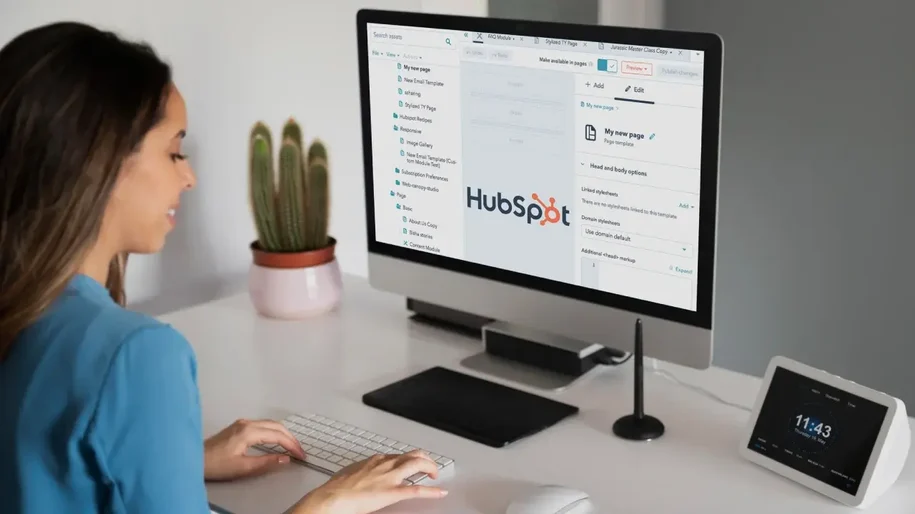Setting up your HubSpot account for the first time is more than just a technical process. It’s the foundation for how your business will manage leads, track customer data, and run marketing and sales campaigns. A smooth HubSpot setup ensures your entire team starts with the right tools, aligned systems, and accurate data.
If your HubSpot setup is rushed or incomplete, it can create long-term issues. From inaccurate reporting to missing leads, even small missteps during the initial configuration can hurt your ability to grow. That’s why it’s essential to pay attention from day one.
Why First-Time Setup Matters For Long-Term Success
A proper HubSpot setup helps teams avoid messy data, broken workflows, and duplicate contacts. It also allows automation, lead scoring, email marketing, and reporting tools to function correctly. When your system is set up well, it saves time, reduces manual work, and supports better customer engagement.
On the other hand, if the setup is flawed, you’ll find yourself constantly troubleshooting. Fixing these errors later takes more effort and can impact your ability to scale efficiently. Getting it right from the start is far easier than going back to fix foundational problems.
Common Signs Of A Flawed Setup Process
There are some early red flags that your HubSpot setup isn’t on track. If contacts aren’t syncing properly, emails aren’t being delivered, or reporting dashboards aren’t accurate, chances are something was missed. These problems usually stem from skipped steps during the onboarding phase or a lack of understanding of how the platform works.
Account Configuration Mistakes To Watch Out For
One of the first places users make mistakes is during account setup. This is where core details get locked in, and skipping them can cause complications later.
Skipping Essential Business Information During Setup
Basic but important items like your company name, domain, and timezone may seem minor, but they affect reporting accuracy and platform functionality. If these are incorrect or missing, it can affect email settings, time-based automation, and how your reports reflect campaign performance.
Incorrect User Roles And Permissions
Assigning the wrong user roles is another common issue. HubSpot allows role-based access so your team members only see the tools they need. Without properly assigning permissions, you risk giving too much or too little access, which slows down workflows and may expose sensitive data.
Failing To Set Your Default Currency And Time Zone
Currency and time zone settings also impact deal tracking and campaign scheduling. If these aren’t configured during the initial HubSpot setup, your revenue forecasts, reports, and scheduled emails might not align with your actual business activity.
Crm Setup Errors That Hurt Your Workflow
After the account settings, the CRM side of your HubSpot setup must be handled with care. This is where your customer information lives and flows through your sales process.
Not Customizing Lifecycle Stages And Deal Pipelines
HubSpot provides default lifecycle stages and pipelines, but they might not match how your business works. If you don’t customise them to reflect your actual process, your sales team might get confused or skip important steps in your funnel.
Poor Contact And Company Property Mapping
Each business needs to define which data fields are most important. If you rely only on default properties, you may miss key customer details. Setting up custom properties based on your goals makes segmentation and automation much easier.
Ignoring Data Import Rules And Formatting
Importing data is where things often go wrong. Without cleaning your spreadsheets or mapping fields correctly, you may end up with missing contacts or mismatched data. A clean import is critical to avoid headaches later.
Marketing Tools Setup Issues That Reduce Efficiency
Your marketing team relies heavily on having the tools in HubSpot working properly from the start.
Unverified Email Sending Domains
You won’t be able to run effective email campaigns if you don’t verify your email domain. This one step affects deliverability and whether your emails land in inboxes or spam folders.
Improper Tracking Code Installation
Without installing the HubSpot tracking code on your website, you’ll miss out on important visitor data. It also prevents you from triggering automation or tracking form submissions accurately.
Not Linking Your Website And Social Media Accounts
Connecting your digital channels to HubSpot ensures you get complete data for analytics and campaign tracking. Many first-time users overlook this step, leading to fragmented data and limited insights.
Sales Tools Misconfigurations That Affect Performance
Sales tools within HubSpot also require proper setup to function at full capacity.
Overlooking Deal Stage Automation
Deal stage automation helps sales teams move faster by eliminating manual updates. If this isn’t configured, tasks fall through the cracks, and your pipeline becomes hard to manage.
Missing Integrations With Key Productivity Apps
Failing to connect your calendar, email, or third-party tools limits HubSpot’s power. When your apps are disconnected, your workflows stay broken and information is siloed.
Misaligned Lead Scoring And Assignment Rules
Without setting lead scoring rules and auto-assignment logic, your team won’t know which leads to prioritise. This slows down your response time and affects conversions.
Reporting And Dashboard Mistakes To Avoid
Reports and dashboards help you understand what’s working. If they aren’t set up correctly, you’re flying blind.
Using Default Reports Without Adjustments
HubSpot offers default reports, but they’re often too general. Tailoring your reports to match your KPIs is a step too many users skip, leading to confusion when reviewing performance.
Misunderstanding Key Metrics And Definitions
It’s important to align your team on what each report metric actually means. Otherwise, stakeholders may interpret the same data differently and make the wrong decisions.
Not Setting Up Goals And Custom Dashboards Early On
You can’t track what you haven’t defined. Setting goals and custom dashboards early ensures every department is measuring what truly matters.
Tips To Ensure A Smooth Setup From Day One
There are ways to make your first-time HubSpot setup as smooth as possible.
Use Hubspot’s Setup Assistant And Onboarding Checklists
HubSpot offers in-platform tools that walk you through setup. These should be your first stop to avoid common mistakes.
Test Automations And Form Workflows Before Launch
Run test submissions and sample automations to make sure everything behaves the way it should. A small test can save hours of rework.
Involve Team Members In Reviewing The Configuration
Everyone should weigh in during the setup. When sales, marketing, and operations align, the system works better for everyone.
When To Get Expert Help With Your Hubspot Setup
Sometimes it’s best not to go it alone. If things start getting confusing, reaching out to an expert can help prevent serious issues down the line.
Indicators That Professional Guidance Is Needed
If you’re unsure about automation logic, integrations, or reporting setup, it’s better to ask for help than try to guess. Delays and mistakes can be costly in both time and revenue.
Benefits Of Working With A Certified Hubspot Consultant
A skilled consultant can configure your account based on your goals, build out custom workflows, and ensure you’re using all the tools effectively. With the right guidance, your HubSpot setup becomes a powerful system that drives results from the start.












